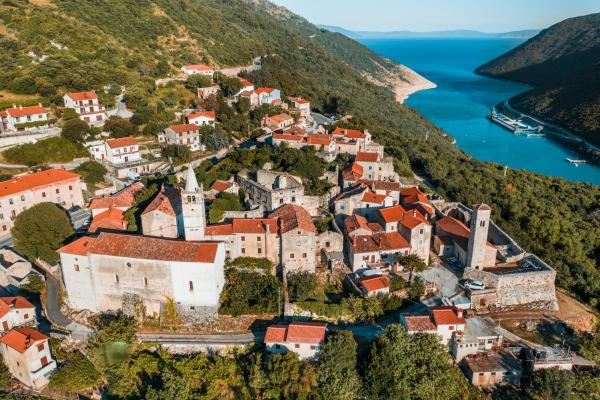The cultural and historical complex of Plomin
The cultural and historical complex of Plomin

Like this article?
Recommend it to your friends through these services..
Plomin is located on a hill above a deep bay. It was inhabited in prehistoric times, while the ancient municipality of Flanona was located in the port at the bottom of the bay. The fortified settlement developed in late antiquity and the Middle Ages.
Like most Istrian castles, Plomin was built on the site of a prehistoric fortress from the 2nd millennium BC, and even its current name originates from that period. In the 1st millennium BC it was ruled by the Liburnians, and then Plomin developed into an important trade and craft centre, continuing to develop even after the fall of Liburnia under Roman rule in 129 BC. During Roman rule, as a gorgeous and rich town near a deep and protected bay, it became a municipium, and the entire Kvarner Bay was named after it - Sinus Flanaticus (Plomin Bay). Due to language changes, the Croatian name came from the name Flanona, just like the Italian Fianona, and there is an interesting legend about it. Allegedly, during the attack of the Uskoks on Plomin in 1599, everyone in the town was killed, except for a granddaughter and a grandmother (fia e nona) who were hidden in the chimney.
Today, it is hard for many to imagine that back in the 19th century, the port of Plomin was full of sailing ships and connected to Rijeka, Cres and Lošinj by regular shipping lines, and that it also had several lodgings. Many respected sailors, fishermen and millers lived in the town. The mills have completely disappeared, and in some places ruins or a few millstones can still be seen, while the port was almost completely abandoned due to the draining of Čepić Lake when the bay was filled with considerable amounts of silt. The port of Plomin had been cleaned of silt for years, and the town was almost abandoned after the Second World War. Nevertheless, thanks to the circumstances, Plomin has completely preserved its medieval appearance, and the fact that it is one of the oldest settlements in Istria can also be seen by the town’s prehistoric urban structure, which was also taken over by the medieval settlement.
This is a typical Istrian medieval town with an irregular ellipsoidal floor plan surrounded by medieval (13th -14th century) and Renaissance (16th-17th century) defensive walls. Today, only small parts on three sides of the town have been preserved, and the rest was demolished in the 18th and 19th centuries or incorporated into the surrounding residential houses. A long street winds its way through the entire settlement, which is joined by a number of cross passages and alleys with rows of Renaissance and Baroque buildings.
The urban structure of the city is condensed. Within the urban fabric, several Renaissance and Baroque residential buildings have also been preserved, and the Baroque structure of Rudan Palace is particularly noteworthy. On the SW edge of the settlement is the Romanesque church of St. George the Old, as well as the Church of the Assumption of the Blessed Virgin Mary. Near the NW tower, the late Gothic building was rebuilt in the Baroque style. The medieval walls have been partially preserved in the structure of the houses built over them. 16th century walls have been preserved around St. George’s church, and on the northern side of the town.
